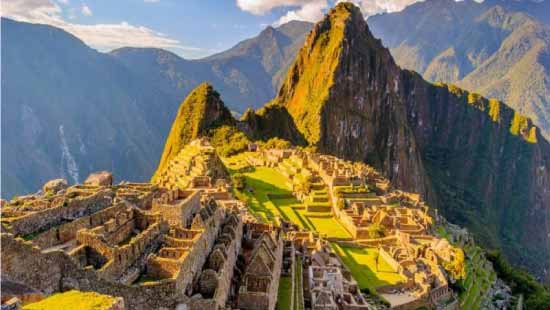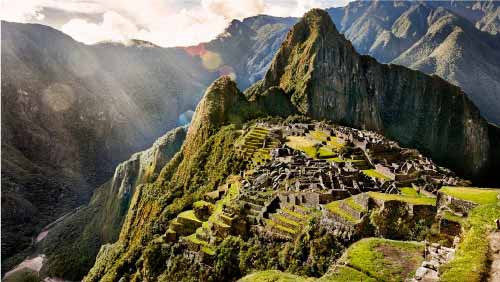The Inca civilization, also known as the Inca Empire, was one of the largest and most advanced cultures in South America, which developed in the Andes region of present-day Peru, Bolivia, Chile, Ecuador, Colombia, and Argentina. The Inca Empire reached its peak in the fifteenth and early sixteenth centuries.
The Incas were known for their architecture, engineering, agriculture and communication system, as well as for their impressive network of roads that connected the entire empire. They were also famous for their skill in metallurgy, ceramics, textiles and jewelry.
The religion of the Incas centered on belief in various gods and goddesses, and on the veneration of ancestors. Inca rulers were considered descendants of the gods and were treated with great respect and reverence.
The Inca Empire was conquered by the Spanish in the sixteenth century, led by Francisco Pizarro. The Spanish conquest had a great impact on Inca culture and society, and many aspects of Inca culture were destroyed or altered. However, there are still indigenous communities in the region that maintain the traditions and customs of the Inca culture.
Its architecture
Inca architecture is renowned for its sophisticated engineering and ability to build durable structures in the steep, rocky Andes Mountains. The Incas used a construction technique called “ashlar” which involved cutting the rocks into precise shapes and then joining them together without the use of mortar.
One of the most famous structures built by the Incas is Machu Picchu, a citadel located on the heights of the Peruvian Andes. Machu Picchu was built in the fifteenth century and is believed to have been used as a ceremonial center and a retreat for the Inca elite. The citadel is composed of a series of agricultural terraces, temples, squares and dwellings, all built with the ashlar technique.
Another important Inca structure is Sacsayhuaman, a fortress located on the outskirts of the city of Cusco. Sacsayhuaman was built in the fifteenth century and has stone walls that reach up to 9 meters high. The walls of the fortress are composed of huge blocks of stone weighing up to 200 tons each.
Other notable structures of Inca architecture include Ollantaytambo, a complex of temples and agricultural terraces in the Sacred Valley of the Incas, and the citadel of Pisac, located in the Peruvian Andes mountain range.
Its engineering
Inca engineering was one of the most advanced of its time and allowed them to build large infrastructure works and irrigation systems in the steep mountains of the Andes.
One of the most impressive irrigation systems built by the Incas is the platform complex at Moray, which consists of a series of stepped circular terraces. Each terrace has a different microclimate, which allowed the Incas to grow different types of crops in the same area. The Moray platform complex is an example of how the Incas ingeniously used the topography of the terrain to their advantage.
Another example of Inca engineering is the road system that connected the entire empire. The roads were built of stone and stretched for thousands of kilometers, crossing mountains and valleys. The Inca road system was used to transport goods and food, as well as to send messages and troops in case of war.
The Incas were also experts in building suspension bridges made of plant fibers. These suspension bridges allowed people and animals to cross rivers and ravines safely.
Inca engineering was a combination of technical skills, mathematical knowledge and an advanced understanding of the topography and environment of the Andes region. Thanks to these skills, the Incas were able to build impressive infrastructure works and irrigation systems that allowed them to develop a prosperous and highly organized society.
Its agriculture
Agriculture was one of the bases of the Inca economy and its agricultural system was very advanced for its time. The Incas used a variety of agricultural techniques, including terraces, irrigation canals, platforms, and drainage systems to maximize food production in the steep Andes Mountains.
One of the most innovative techniques used by the Incas was the construction of andenes, which are stepped terraces built into the slopes of the mountains. The Andenes allowed the Incas to grow on land that would otherwise be impossible to cultivate and also allowed them to grow different types of crops in the same place.
The Incas also used sophisticated irrigation systems to irrigate their crops. They built irrigation canals that carried water from rivers and streams to growing areas, and they also built drainage systems to prevent flooding and protect crops from excessive rainfall.
In addition, the Incas also used fertilization techniques such as “tumpu” or fertilizing the soil with guano from seabirds and the “jacha” or burning of vegetation to fertilize the soil.
The most important crops of the Incas included potatoes, corn, quinoa, beans and pumpkin. They also grew cotton and used advanced weaving techniques to produce high-quality clothing and textiles.
Inca agriculture was very advanced for its time and allowed the Incas to develop a prosperous and self-sufficient society in the steep mountains of the Andes. Advances in irrigation, fertilization and terraced techniques allowed them to maximize food production and grow a variety of crops in a harsh environment.
Your communication system of the Inca civilization
The Inca communication system was based on a system of roads that connected the entire Inca empire and a system of quipus that was used to transmit numerical and textual information.
The Inca trails were an impressive network of trails that stretched for thousands of kilometers, traversing mountains and valleys. They were built with stone and were designed to be passable by people and animals. The roads were used to transport goods and food, as well as to send messages and troops in case of war.
The quipus system was a numerical and textual communication tool used by the Incas. It consisted of a set of strings of different colors and textures with knots in them. Quipus were used to record information such as censuses, taxes, inventories, and historical events. Quipus were used to transmit information between different regions of the empire and allowed the Incas to keep an accurate record of their society and economy.
In addition, the Incas also used a system of messengers known as “chasquis” to send messages throughout the empire. The chasquis were runners who specialized in running long distances through the Inca trail network to deliver important messages and news. The chasqui system was very efficient and allowed the Incas to send messages quickly throughout the empire.
The Inca communication system was based on a network of roads, a system of quipus and a system of messengers to transmit information throughout the empire. These systems allowed the Incas to maintain effective communication and keep an accurate record of their society and economy.
Religion of the Inca civilization
The Inca religion was polytheistic and animistic, meaning they believed in multiple gods and animate spirits that dwelt in nature. The Inca religion focused on the veneration of the sun, known as Inti, and the earth, known as Pachamama.
The Incas believed that the Inca emperor was a direct descendant of the god Inti and that he had the divine right to rule over the empire. Therefore, the cult of the sun and the emperor was strongly linked in the Inca religion.
The Incas also believed in life after death and practiced complex funeral rituals to prepare the dead for their journey to the afterlife. These rituals included mummification and burial of bodies, as well as the placement of offerings and personal items in tombs.
In addition, the Incas practiced human and animal sacrifices in some cases. Human sacrifices were mainly performed on special occasions, such as the coronation of a new emperor or during a crisis in which the gods were believed to require a human offering to calm their anger.
The Incas also built temples and shrines dedicated to their gods and animate spirits. These sacred places were located in important natural places, such as mountains, lakes and rivers, and were carefully maintained and revered by priests and common people.
The Inca religion was polytheistic and animistic, with a strong focus on the veneration of the sun and the earth. Emperor worship was also linked to religion, and the Incas practiced complex funeral rituals, as well as human and animal sacrifices on some occasions. The holy places were carefully maintained and venerated by the common people and priests.


